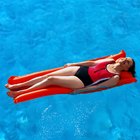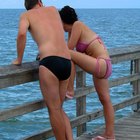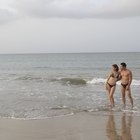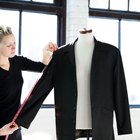Speedo is a brand of swimwear, but the term popularly defines a small, short and tight bathing suit worn by men. Speedos are designed for swimming, as their lightweight, slick fabric and skin-hugging shape helps to increase a swimmer's speed. They are also good for tanning as most of the skin is exposed. Since the 1970s, Speedos have been a notoriously revealing swimsuit choice and there are some etiquette should be observed especially in North America.
Where to Wear
Speedos may be fun and convenient to wear. They are suitable for the beach, pool or private boat but not in general public. Some news events have reported that Speedos worn in public areas such as stores, restaurants, parks, libraries -- even around the neighborhood -- may cause a social disturbance. One USA Today article tells of a case in Arkansas where a man was charged with indecent exposure for wearing Speedos and a small shirt into a restaurant. Bring shorts and a shirt to wear over your Speedo once you leave the swimming area. Keep a towel on hand, which you may wrap around your waist for bathroom trips or emergencies. Wear flip flops with your Speedo on deck.
Who Can Wear
Speedos are suitable for boys and men. However, they are often associated with blatant sexuality in adults. Their super-tight contours and clingy fabrics are revealing and suggestive. Men should take steps to reduce the offensive properties of a Speedo in every context. In Europe, Speedos are far more acceptable in social swimming situations than in North America, where body image and exposure is an issue of manners.
Speedos are for anyone, but their design favors youth or men with trim athletic builds. Men who are heavy, very thin or over forty years of age should avoid Speedos. All of these groups look more attractive and better concealed in fitted trunks or fuller boxers. Ill-fitting Speedos cause body parts to hang out, clothes to slip down and emphasizes bulge. This is risky and impolite.
Proper Wear
Speedos should fit properly. They must look and feel comfortable and come correctly sized. Get help from a store clerk if needed. Bathing suits that are too small pinch or irritate the skin and "stuff" the body in place. Suits that are too large may flap or hang open especially in the water.
Speedos should sit on or just above the hip and pelvic line, and lie flat against the body on all sides. The bottom should be fully covered. The seams and elastics should be fitted and snug but not tight. Be sure that nothing personal is exposed, including pubic hair. Move around, lie down, squat and jump to test the coverage and capacity of your suit, particularly at the edges. The crotch area should be loosely "nested" with room to "breathe." Avoid provocative looks.
If your Speedos are faded, worn or loose, buy a new pair. Choose opaque materials that are not too thin. The best keep you dry and prevent chafing. Colors should be simple and sensible. Dark and neutral colors work best for an attractive, masculine look. Gregarious colors like neon orange can be considered gaudy. Etiquette also includes hygiene. Adult males should employ good grooming habits and keep clean.
Related Articles

What Not to Wear to a Nightclub

What Are the Benefits of Wearing a ...

What Do You Wear for Gymnastic Practice?

Good Swimsuits for Large Stomachs

Styles for Plus Sized & Short Waisted ...

Dry Suits vs. Wetsuits

What to Wear to a Night Club

When to Wear a Wetsuit in Open-Water ...

How to Look Good in a Speedo

Business Dress Etiquette in Saudi Arabia

How an Executive Woman Should Dress

How to Wear a Speedo

How to Know if You Can Wear a Slim Fit ...

How to Wear a Suit in the Rain

What to Wear to the Beach in Winter

Rash Guard for Swimming

How to Size Compression Shorts

Clothing Styles for Big Butts

Clothing Styles for Overweight Teens

What Is a Thermal Shirt?
References
Writer Bio
Sarah York has been a freelance writer and editor for five years. Her work has appeared in such journals as The Danforth Review, Pisgah Review and The Renaissance of Teaching and Learning and in various online sources. She holds both a B.A. in English and M.A. in Creative Writing from the University of Toronto, as well as an M.A. in Literature from Western Carolina University.